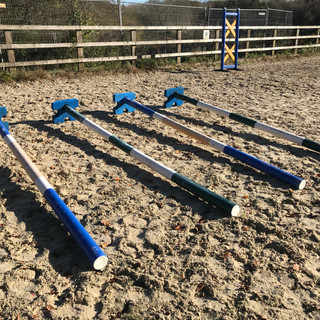Too dark and cold to hack and bored of endless circles in the school? Want your horse to be more balanced, with better engagement, core strength and improved topline?
Here are some simple pole exercises to add variety to your winter schooling programme without breaking a sweat, or even having to tack up! These exercises are performed in walk, so you can lead your horse in hand and even leave your horse's rug on; just make sure it allows for good shoulder movement. If you'd rather stay on board they can be done ridden too.
Replacing just one of your weekly schooling sessions with some in-hand polework can make a big difference...and leave you more time for eating mince pies by the fire!
Straight line poles
Good for...
Core strength
Building topline and improving limb musculature
Stride length
Joint range of motion
Balance, coordination and proprioception
How...
Space the poles so your horse is able to take single steps over each pole, note these are much closer than trotting poles. This horse has a fairly short stride and the poles are approximately 85cm apart - try your horse over fewer poles to get the right distance before increasing the number of poles.
You can increase the difficulty of this exercise by raising one end of the poles. You can then work nearer or further away from the raised end to vary the intensity.
Fan/poles on a circle
Good for...
As above plus:
Lateral flexibility
How...
Place the poles on the same walking distance as the straight poles (measured at the centre of the poles). Work your horse in the centre of the poles or towards the outside to increase the difficulty - make sure they are able to clear the poles comfortably. This configuration can also be done on the lunge.
Difficulty can be increased by raising one end of the poles, as with the straight poles.

Hogs Back
Good for...
As above plus;
Working the outer and inner (lateral and medial) limb muscles
How...
Work your horse in a serpentine over the poles. Start with wide loops so you are approaching the poles on a straight line, gradually making the loops shallower so you are travelling down the poles as straight as possible, with the horse almost side stepping over them.
You may want to start with the poles on the ground, moving on to raising alternate ends once you and your horse are comfortable with the exercise.

Do's and Don'ts
DO warm your horse up first with a few laps of the school on each rein - this is especially important if they have been stabled prior to exercise.
DO work evenly on each rein - ensure you do the same number of passes in both directions
DO use heavy/wooden poles if possible - it can become annoying having to constantly replace displaced poles!
DON'T ask your horse to continue any exercise they are finding too difficult - consistantly knocking poles is a sign your horse is struggling and the exercise should be ceased immediately.
Disclaimer: Horses are unpredictable animals and can be dangerous. Exercises are carried out at your own risk and Sarah Read accepts no responsibility for accident or injury caused.






